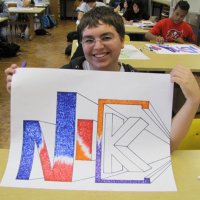Project-Based Learning as a Context for Arts Integration
Your content has been saved!
Go to My Saved Content.Project-based learning can provide an intentional and effective opportunity to integrate the arts across disciplines and curriculum. While valuable as a stand-alone discipline, arts education can be given further power and value when used in a PBL project as part of the core curriculum.
When teachers begin designing PBL projects, they often start small, maybe with a recommended idea to internalize the design process and a reflection on how to improve. As teachers become more familiar with PBL, integration is a great next step for taking it up a notch. This is where the arts come in! If you are thinking about your next PBL project, consider using one or more of these intentional moments to integrate art.
The Arts as the Entry Event
When launching a PBL project, it is crucial to have an entry event that engages students and creates excitement for the project. From movies and music to activities and simulations, teachers can launch a project with one or more entry events that relate to the arts. Start the project with an art anchor text, not only to build inquiry, but also to keep the momentum going along the way by revisiting that anchor.
The Arts in Culminating Products or Performances
PBL demands voice and choice in how students spend their time and how they show their learning. Each project culminates in a presentation or product that is presented to a public audience. The best products meet the needs of the audience, which means that creating the project must focus not only on relevance, but also on engagement. Teachers can use this design element to further leverage the arts by providing an arts product as one or more of the choices. We know students can show their learning in a variety of ways and through multiple intelligences. In addition to a persuasive letter, consider a collage or songbook of lyrics.
The Arts as Scaffolding
Students need scaffolding through a variety of instructional activities that will arm them with the skills and content they'll need to be successful on the project. As you consider this scaffolding, include arts-related activities. Use these activities to help students process their content and represent their thinking. For example, have students do a "tableau" activity where they represent the structure of the cell. From this, the teacher helps students metacognitively and transparently connect this individual activity to the larger project. Students learn from this arts-based activity during the project and will apply it to their product. Role-plays, simulations, music comprehension strategies, visual processing, dramatic acting -- all these activities and more can help support and scaffold the many learning targets within a PBL project.
The Arts As Formative Assessment
Similar to assessing their students' culminating products or performances, teachers must formatively assess learning objectives and skills throughout the PBL project. As students participate in scaffolding and activities, use the arts as the method to formatively assess content and 21st century skills. If you are assessing collaboration, use a visual representation as evidence.
While arts integration in the core discipline alone is valuable, doing it within the context of a PBL project can make the integration seamless as well as valuable. PBL projects provide a space to meet multiple learning targets, whether those are core discipline standards or arts standards. Whether or not you are intending to assess arts standards on your PBL project, you can still find intentional instructional moments for using the arts, not only to value them, but also to create engagement for everyone. Your students can learn the arts as well as learning through the arts.
